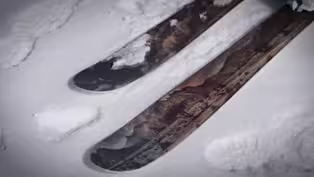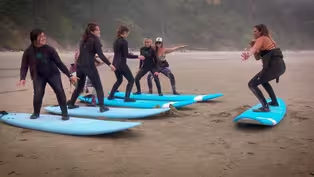Oregon Field Guide
Gemstone Faceting
Clip: Season 34 Episode 8 | 4m 47sVideo has Closed Captions
Ever wonder what makes a gemstone sparkle? It’s all in the faceting!
Ever wonder what makes gemstone sparkle? It starts with the way a crystal reflects and refracts light. Gemstone cutters must choose a design with the right angles for that stone, so that light passes through, bounces back to the top and catches the eye of the beholder. Karl Ziltener of the Columbia Willamette Faceters Guild shows us how he turns a raw Oregon sunstone into a glittering jewel.
Problems playing video? | Closed Captioning Feedback
Problems playing video? | Closed Captioning Feedback
Oregon Field Guide is a local public television program presented by OPB
Oregon Field Guide
Gemstone Faceting
Clip: Season 34 Episode 8 | 4m 47sVideo has Closed Captions
Ever wonder what makes gemstone sparkle? It starts with the way a crystal reflects and refracts light. Gemstone cutters must choose a design with the right angles for that stone, so that light passes through, bounces back to the top and catches the eye of the beholder. Karl Ziltener of the Columbia Willamette Faceters Guild shows us how he turns a raw Oregon sunstone into a glittering jewel.
Problems playing video? | Closed Captioning Feedback
How to Watch Oregon Field Guide
Oregon Field Guide is available to stream on pbs.org and the free PBS App, available on iPhone, Apple TV, Android TV, Android smartphones, Amazon Fire TV, Amazon Fire Tablet, Roku, Samsung Smart TV, and Vizio.
Providing Support for PBS.org
Learn Moreabout PBS online sponsorship(breezes blowing) - [Narrator] The Rice Museum of Rocks and Minerals is full of natural treasures.
But down in the basement, Karl Ziltener is doing nature one better.
- So we've gone to the sunstone field, and we've found us a bag full of rocks.
- [Narrator] These rosy colored rocks are Oregon sunstones.
- Sunstone is the Oregon state gemstone.
It makes nice pendants and earrings and things like that, and that it just loves to be shiny, so it polishes easy.
Even the straw colored ones, which are pretty common, turn out a beautiful stone.
We're gonna look for a stone that is big enough to cut something out of.
Now if you get one like this, that's a fair sized stone.
- [Narrator] Karl checks the stone for cracks.
- So that we don't have one that falls apart after we put some work into it.
Okay, so that might work for what we're going to do.
- [Narrator] There are any number of ways to cut a stone.
- Okay.
- [Narrator] But each faceted gem has a few standard features.
- A gemstone has five major parts.
It has the crown, the girdle, and the pavilion.
It also has a table, which is the very top.
It also has a culet, which is the very bottom.
- [Narrator] Karl's going to cut an eight-sided shape called a pedal eight.
- For this kind of stone, I decided I would do the girdle first.
Now the girdle ties the top and the bottom together.
- [Narrator] Next, Karl moves onto the pavilion, the longer facets that make up the bottom of the cut.
This is when getting things just right is critical.
- We as faceters get to play with light.
The main facets on the pavilion need to be at a proper angle, so that the light goes down through the stone and reflects and comes back out the top, rather than bounce out the sides.
- [Narrator] If the pavilion is too shallow or too deep, light won't bounce back to the top, and the gem won't appear to sparkle.
So getting those facets the right angle is essential.
And on a clear stone, that isn't easy.
- We're gonna paint the stone.
By doing this, we can look at it and see what's happening on the stone.
- [Narrator] Even when everything is just right, sunstones can be tricky.
- Ooh, something went wrong, because I got one facet I cut too deep, so I'm gonna have to go back and recut those.
Sunstones are an interesting critter.
I like to work with them, but they have soft sides, and you can get yourself in trouble big time on cutting them.
One of them you'll overcut, and the other one not quite enough, and all of a sudden you're all over the place.
So it's just a love/hate kind of thing, let's put it that way.
(grinding) There we go, now we got a nice sharp point and a nice flat girdle line all the way around there.
- [Narrator] Once the pavilion is just right, the bottom of the stone is pretty much done.
- At that point, ready to turn it upside down.
- [Narrator] Add a little dab of glue, a little blue ink to make the facets visible.
- Now we can grind on the crown.
Let's have at it here.
(grinding) And I pronounce it ready for a table.
- [Narrator] Once that flat spot on top is done, the gem is ready for a good polish.
- Everything that comes up should be nice and shiny.
You shouldn't have any dull spots.
I declare that stone done.
Shall we take it off and look at it?
Nature gave us some nice looking things, wonderful things.
And following the rules of light and all of that, we can really enhance them and make them really sparkle, so to speak.
(machine noise) (no audio) - Getting inspiration for your next adventure?
It's kind of why you're here, right?
Or you can support more of what we do on Oregon Field Guide and everything else you see on OPB by going to op.org/video and becoming a sustaining member.
Video has Closed Captions
Clip: S34 Ep8 | 11m 31s | A remote workshop offers custom ski making. (11m 31s)
Video has Closed Captions
Clip: S34 Ep8 | 8m 48s | A surf camp for tribal members along the Oregon coast. (8m 48s)
Providing Support for PBS.org
Learn Moreabout PBS online sponsorshipSupport for PBS provided by:
Oregon Field Guide is a local public television program presented by OPB

















